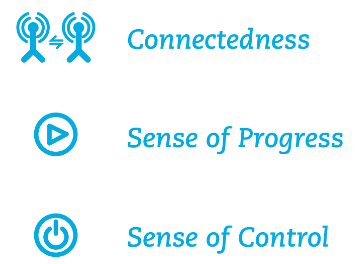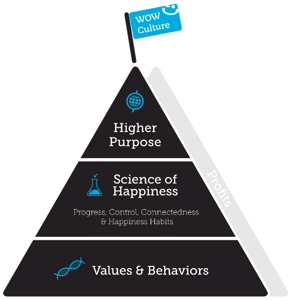.png?width=790&name=dh%20101%20sunny%20blog%20(3).png)
It’s no secret that how we feel at work is key to our performance. Feelings drive our behavior from within and account for about 90% of our motivation. The last decade of research coupled with results from companies like Zappos using emotions to elevate performance has blown up the myth that emotions don’t matter!
But how do you manage emotions at work, and sustain the elusive one called happiness? Businesses increasingly need to understand this because when employees are happy, organizations benefit - realizing the potential of 17% higher productivity, 20% higher sales, and 21% higher profitability [Gallup]. Those who want to understand how to implement a culture change assess how aligned they are with their core values and purpose.

We identified three elements from the science of happiness in our Hello Doc that not only achieve measurable results but also make deep human sense for companies around the world. These elements can be pulled, like levers, to increase engagement at work. They are simple to grasp, and once you get the hang of them, there are abundant opportunities to turn them into business results.
One of the most powerful motivators for us humans is simply making progress toward meaningful goals. This sense of progress applies in spades at work, and goes right to some of our most profound cravings; to contribute, to grow, to see that our actions matter. A new meta-analysis highlights how important this feeling is, offering a new definition of thriving as growing and getting better at something.
Think of the opposite. When we feel like a hamster in a wheel, our motivation flatlines. What’s the point? Or more subtly, the decline of the annual review. Getting feedback once a year is not enough to feel like we’re progressing in the right direction. High achievers want feedback immediately, often, and in positive formats. As Mary Kay said once,
“There are two things people want more than sex or money, that’s recognition and praise.”
Progress can be sensed from celebrating milestones to recognition to learning new skills to receiving feedback. Arkadium named one of Inc.com’s “Best Places to Work,” has embedded a sense of progress into their Monday Morning Meetings with a minimal budget, just enough for Post-it Notes.
Every employee receives a pad of sticky notes that read, “Lil’ Wins,” and under they jot down tiny accomplishments throughout the day. When there are exactly two minutes left in the meeting, a timer begins, the energy picks up, people shout out wins big and small, from buying a house to finishing a book! Cheering and applause ensue, and they head into their Monday with their minds wired for progress, motivated to start the week.
Younger generations are guilty of helping the rest of us get used to this lever. About 59% of Millennials say the “opportunity to learn and grow” is a deciding factor in job selection. Instead of being swayed by stocked fridges and ping-pong tables, they want to know how an organization will help them learn and grow in their careers.
With twenty years of positive psychology to review, the research still says happiness is about relationships. We are social animals; we’re just living in the digital era. Our need for each other runs deep. As Brene Brown says, “Connection is why we’re here, it’s what gives us meaning and purpose in life.”
.png?width=320&name=Connectedness%20is%20the%20central%20force%20for%20thriving%20organizations%20(1).png) Connectedness is a central force for thriving organizations. It’s the thread that weaves relationships, projects, and teams together. Connection increases empathy as we see similarities in others. Teamwork as we care about each other more. Personal resilience as we build social networks. And success, both individual and organizational, as we work better together.
Connectedness is a central force for thriving organizations. It’s the thread that weaves relationships, projects, and teams together. Connection increases empathy as we see similarities in others. Teamwork as we care about each other more. Personal resilience as we build social networks. And success, both individual and organizational, as we work better together.
With seven billion people on this planet, one of the most overlooked problems in the world today is loneliness. Technology has helped us to master the breadth of connection, but now we have less depth. Increasingly, we are alone together on Facebook - connected superficially through social media.
We can achieve more depth in our relationships by showing up authentically as who we are, realizing meaningful connections to others, and developing friendships at work. It’s not enough to get along with the people at work. Close and authentic bonds build meaning and business results. In fact, having a best friend at work increases engagement an incredible seven-fold. And when 6 out of 10 employees have a “best friend” at work, organizations see 36% fewer safety incidents and 12% higher profit.
Zappos has ingrained the lever of connectedness with their long-held 20% rule. Leaders are encouraged to spend 20% of their time outside of work with their team. They are free to do this in any way they like, from bonding at the bar to hiking Las Vegas' Red Rocks. The rule allows them to share interests outside of work and, importantly, to just be who they are, unguarded real people, undefined by projects and roles. This sharing brings out passions, interests, and similarities, forming a strong basis for meaningful bonds. It creates the psychological safety to be ourselves and unleashes a powerful energy in our work. We feel accepted, safe, and true belonging. This confidence spirals out to impact other areas of work, like innovation. Zappos found some of their best ideas come when they are connecting outside of work with a relaxed mindset.
Organizations successfully using connectedness don’t leave it to chance. They proactively schedule time for building relationships. Hubspot named one of Glassdoor’s “Best Places to Work,” encourages authentic connection with pancake breakfasts once a week. For the cost of some batter, they create as an outlet for free-form communication, a ritual to build lasting team bonds, and comic relief for some leaders’ pancake creations gone wrong!
Control is about autonomy. Ultimately, we all want to be masters of our own destiny. As Dan Pink shows in his book Drive, autonomy is a deep, intrinsic motivator. The freedom to do our own work, in our own way drives us to do more. We feel a sense of ownership as we strengthen our talents. We become motivated to expand as people and in our roles. And we find ways to improve how work is done.[1] Feeling control fulfills our human need to see that we uniquely matter: our time matters, our choices matter, and our ideas matter. As Albert Einstein said,
“Everything that is truly great and inspiring is created by the individual who labors in freedom.”
An increasing sense of control could include flexible work schedules, paths with a clear career direction, choice of role titles, or input on decisions. This lever is especially vital because control goes hand-in-hand with trust. When control is extended, trust is built. Empowering teams with both freedom and accountability reinforces trust and builds a culture where everyone is empowered to do their best.
Many young companies are pulling the control lever with job crafting and titles. Chinese e-commerce giant Alibaba asks employees to choose a kung-fu-nickname, and their leadership leads the way. CEO Jack Ma is ‘Unpredictable and Aggressive,’ while COO Daniel Zhang is ‘Free and Unfettered!” The fun names create ownership and individuality while minimizing ego, and making everyone, leadership especially, more approachable.
.png?width=320&name=shereen%20quote%20(1).png) Another key way to engage control is through transparency. We’ve all heard the benefits of transparency in creating emotional safety, trust, and belonging. It also extends control, by sharing instead of protecting information.
Another key way to engage control is through transparency. We’ve all heard the benefits of transparency in creating emotional safety, trust, and belonging. It also extends control, by sharing instead of protecting information.
The social media company Buffer takes this concept to new heights with an open-source salary calculator. Not only can employees see each other’s salaries, they’re actually public! In an age when information is abundant, radical transparency empowers employees with information to take control of their career path.
For businesses and for our actualization as humans, the opportunity is for your organization to proactively design a culture of happiness by encouraging a sense of progress, control, and connectedness in the workplace. Ritualizing and embedding the right actions and behaviors that promote these is how to build a sustainable culture of happiness.
Ask yourself:
[1] Greenberg, M., & Maymin, S. (2013). Profit from the Positive: Proven leadership strategies to boost productivity and transform your business.

Currently the Culture Chief at DH, Sunny’s mission is to inspire others to live BIG by being true to themselves and following their purpose. She is passionate about realizing this through positive work cultures. Through her diverse journey Sunny has been a wellness researcher, saké trainer, ultra-runner, one of the world’s first happiness coaches and, finally, a global culture consultant.